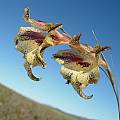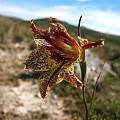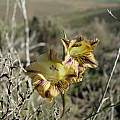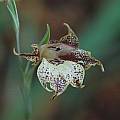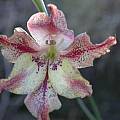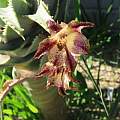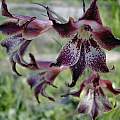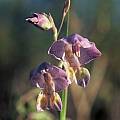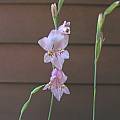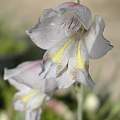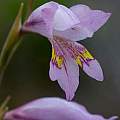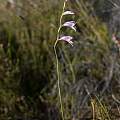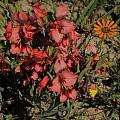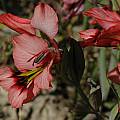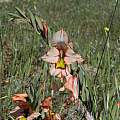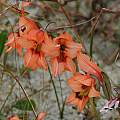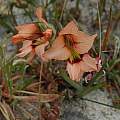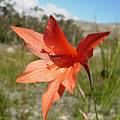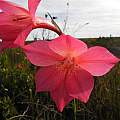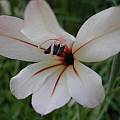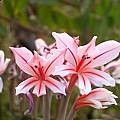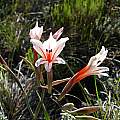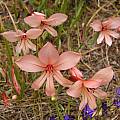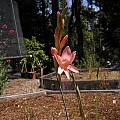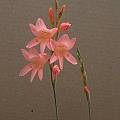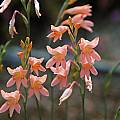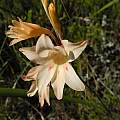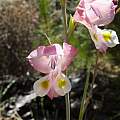Winter rain Gladiolus like their winters wet and mild and may need a dry summer dormancy. They are often less hardy, reaching down to USDA zone 8 at most.
Page 1: G. abbreviatus... Page 2: G. bonaspei... Page 3: G. carmineus... Page 4: G. debilis... Page 5: G. gracilis... Page 6: G. inflatus... Page 8: G. mutabilis... Page 9: G. pulcherrimus... Page 10: G. saccatus... Page 11: G. teretifolius...
Gladiolus maculatus Sweet extends across the southern coast and immediate interior of the winter rainfall area to the Eastern Cape where it is often found growing in heavy soils in renosterveld. Flowers are dull yellow to lilac and speckled with brown or purplish spots. They are long-tubed and fragrant during the day and the evening. The first three pictures were taken by Cameron McMaster near Napier and Bredasdorp in the Overberg.
The first two pictures below are of garden flowers taken by Mary Sue Ittner December 2007 and January 2009. The next two were taken by Alan Horstmann and the last by Dirk Wallace.
Gladiolus marlothii G.J.Lewis is endemic to the Roggeveld Escarpment. It grows on open slopes or among rock outcrops, always in heavy clay and usually in rocky situations at an elevation of 1800 m. Flowers are pale blue-lilac with a transverse yellow band about the base of the limb and are densely speckled with dark purple at the edges of the yellow band. Photograph taken by Rod Saunders.
Gladiolus martleyi L.Bolus syn. Gladiolus pillansii grows on sandy and rocky flats in the northern and southwestern Cape and blooms in the fall on a flowering stalk without leaves. Growing from 30 to 60 cm, it has usually scented pale to pink or lilac flowers. The lower lateral tepals each have a transverse band or a spear shaped yellow mark edged darker pink or purple in the upper half. The first photo by Bob Rutemoeller shows one grown from IBSA seed from Betty's Bay. The second photo was taken by Dirk Wallace. Other photos taken by Christopher Whitehouse in the Phillipskop Mountain Reserve.
Gladiolus meliusculus (G.J.Lewis) Goldblatt & J.C.Manning, syn. Gladiolus alatus var. meliusculus is found on low hills and flats on the western Cape coastal plain where it grows in sandy sites formed from decomposed granite or sandstone that are waterlogged during the period of growth. Flowers are salmon, brick-red or orange with yellow markings on the lower tepals. Gladiolus meliusculus differs from Gladiolus alatus by having shorter stamens and the yellow on the lower tepals is less pronounced and edged by a band of red-purple and the upper halves are pink to orange. The first three photos were taken by Mary Sue Ittner and Bob Rutemoeller September 2006 near Darling. The other two were taken near Brackenfell on Rod and Rachel Saunders' property where they are growing this species.
Gladiolus meridionalis G.J.Lewis is found in the Southern Cape from the Overberg to Port Elizabeth (both winter and summer rainfall areas) and flowers from June to August. The distribution is discontinuous. Plants grow in stony sandstone soils in low fynbos on mountain slopes and flats that are usually in sight of the ocean. The populations in the west of the range have dark pink to salmon flowers and those in the east have cream to pinkish orange flowers. Flowers are adapted for pollination by sunbirds with a long perianth tube. An article here describes a rare finding of this species. The first photograph from Cameron McMaster was taken on the farm Fairfield in the Napier district where it occurs on sandstone slopes. The second photo was taken by Rachel Saunders.
Gladiolus miniatus is found on coastal limestone outcrops from Hermanus to Agulhas. Spring blooming flowers are salmon with red along the midline. The first photo was taken by Dirk Wallace and the second and third by Cameron McMaster at Arniston. The last two photos were taken by Mary Sue Ittner in May 2005 when they were blooming for the first time from seed in Northern California with California bulb companions Brodiaea jolonensis, Allium unifolium and Triteleia hyacinthina in bloom in the same raised bed.
Gladiolus monticola is found on rocky sandstone slopes in the southwestern Cape. There are populations on Table Mountain. It has pink to apricot flowers with darker pink markings on the lower tepals and blooms summer into fall before the single leaf is produced. The first two photos by Bob Rutemoeller. This first photo shows it as the only bulb blooming in one of our raised beds that only has bulbs from winter rainfall areas, blooming in July 2003 in the northern hemisphere. The leaf in the picture is of another Gladiolus that bloomed a month earlier. In the second photo we put cardboard behind the flowers to get the close-up that shows the details better. The third photo was taken years later by Mary Sue Ittner. The last photo from Rachel Saunders was taken on Table Mountain February 2011.
Gladiolus mostertiae is found in wet sandy soils in the Bokkeveld Mountains in the Northwest Cape. Growing 25 to 30 cm high, this species has linear leaves with a thickened midrib and pale pink flowers with yellow-green markings on the lower tepals. It flowers November to December. Photo taken by Rachel Saunders November 2013 near Nieuwoudtville in a year with late rainfall so the soil was still wet when it bloomed.
Page 1: G. abbreviatus... Page 2: G. bonaspei... Page 3: G. carmineus... Page 4: G. debilis... Page 5: G. gracilis... Page 6: G. inflatus... Page 8: G. mutabilis... Page 9: G. pulcherrimus... Page 10: G. saccatus... Page 11: G. teretifolius...
